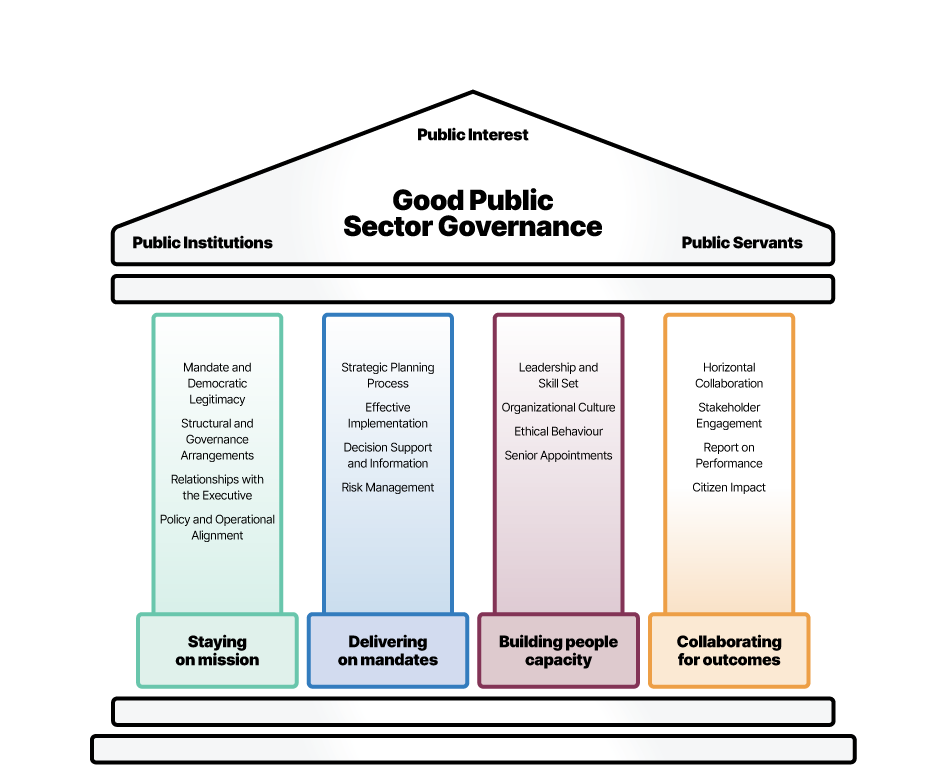Governance Assessment Framework
The Four Pillars
Today’s governance environment is increasingly complex. Public organizations must be adaptive in the face of change, innovative in addressing complex, cross-cutting challenges, and responsive and collaborative to deliver outcomes that build citizen trust. But what exactly is good governance and how can your organization achieve it? We’ve distilled the four pillars of good governance – each of which follows recognized good governance principles:

Staying on Mission
Your governance steers your organization in the right direction to fulfill a clear public purpose. Your organization ensures that its internal structures, governance arrangements, and external relationships are aligned to achieve this mission and address the realities of the public policy environment in which you operate.
Delivering on Mandates
Your governance is aligned to your mandate. Your organization has the right internal structures, processes and practices – including strategic planning, operational planning, committee structures, and risk management – to deliver on your mandate in a fully accountable way.
Building People Capacity
Your governance team is in peak working order. Your organization has the right people capacity of skills and culture needed to perform. Leadership and skills development are advanced fairly and proactively.
Collaborating for Outcomes
Your governance engages others. Your organization collaborates meaningfully with citizens, stakeholders, governments and other public institutions to address horizontal, multi-sectoral and jurisdictional public policy challenges. Collaborative governance practices are put in place to meet citizens’ needs better and increase public trust. You communicate outcomes transparently to citizens.
Success Factors
Our proprietary tool provides a focused, principle-based means to assess and improve an organization’s current governance structure, process, and practices. We have identified key Success Factors in each pillar to guide governance improvements.
Staying on Mission
| Success Factors | What does success look like? |
| Mandate and Democratic Legitimacy | The organizational mandate is duly constituted and clearly understood in terms of a recognized public interest. |
| Structural and Governance Arrangements | The organizational structure and internal governance arrangements support the organizational mandate. |
| Relationships with the Executive | There is an ongoing, constructive, and appropriate relationship with the executive branch that supports the effective achievement of the organization’s mandate. |
| Policy and Operational Alignment | The organization’s activities are aligned with the broader public agenda as appropriate. |
Delivering on Mandates
| Success Factors | What does success look like? |
| Strategic Planning Process | Comprehensive strategic planning processes and plans are in place outlining key objectives, strategies, business plans and budgets, risk management, specified outcomes and performance metrics. |
| Effective Implementation | Strategic planning influences decision making and operations, and ongoing operational plans are in place. |
| Decision Support and Information | An effective and efficient committee structure is in place that allows duly informed decisions to be made at the appropriate level and supports informed, strategic decision making by the leader of the organization. |
| Risk Management | A robust risk management framework is in place, reviewed regularly, and integrated into operations. |
Building People Capacity
| Success Factors | What does success look like? |
| Leadership and Skill Set | The organization has the people it needs to deliver on its mandate now and in the future. The necessary executive skills and leadership are in place, supported by effective succession planning and professional development. |
| Organizational Culture | Organizational culture is inclusive of diverse perspectives, supports effective decision-making, and encourages recruitment and retention. |
| Ethical Behaviour | A comprehensive body of conduct norms (conflict of interest rules and ethics codes) define the standards of professional behaviour expect of all appointees and staff, and robust systems of monitoring and enforcement are in place. |
| Senior Appointments | Appointments are made on a timely basis pursuant to an open, merit-based process that ensures the required skill set is in place. |
Collaborating for Outcomes
| Success factors | What does success look like? |
| Horizontal Collaboration | Processes and practices support horizontal collaboration between organizations to address complex public challenges. |
| Stakeholder Engagement | Stakeholders are meaningfully consulted and the organization benefits from their input. |
| Report on Performance | Systematic, ongoing reports on organizational objectives, planning, and performance, including financial reporting, are provided to the executive, legislature, and oversight bodies, and disclosed to citizens. |
| Citizen Impact | Citizens have the knowledge and information needed to evaluate achievement and impact. |